Capoeira - that is, a martial art or dance?
Brazil is known to us not only great footballers and bright matches, but also an unusual martial art that combines dance, play, acrobatics and the desire for freedom. Capoeira - that this kind of a brutal fight or dance sport? The answer to this question is not everyone knows, because it does not give so easy. But for a better understanding, you can learn the history and distinctive features of capoeira, self-designating for himself the need for it in their lives.
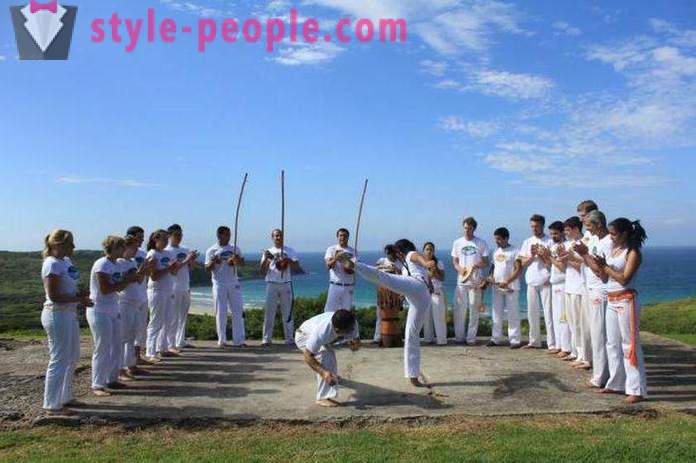
Capoeira - what is it?
Absolutely you can meet a group of people in every corner of our world, regularly get together, becoming in a circle (the genus) and beginning their unusual game (Zhogu). Capoeira classes are common everywhere, because they do not pose any particular difficulties, even for people who have the word "capoeira" seems quite alien.
A couple of players out in the middle of the circle, and then give birth to rhythmic music dance battle. It combines the punches and tumbling movements. The participants demonstrate to ourselves and to others a knack own body. This is what has been called "capoeira". What is it - a kind of martial arts, fitness, or simply the magic word, each defines for himself. After all, it can be used to learn how to perform acrobatic tricks to lose weight and strengthen muscles.

History
To date, it formed quite a lot of opinions, conjectures and hypotheses, often contradictory, giving an answer to the question: "Capoeira - what is it?" The earliest reliable data were obtained at the beginning of the 17th century. Since that time in the written sources began to gradually appear some references to capoeira. Around 1500, when the world was a lot of great geographical discoveries, the Portuguese went to Brazil for the gold reserves and free labor. Unfortunately, with the locals, they miscalculated. From the very savages it could not be slaves to do, because they died in captivity, ran and worked badly. Therefore, it was necessary to establish the Portuguese import of labor directly from Africa. Some sources claim that the history of Brazil have been sold for a lot of money to more than 4 million slaves, previously lived in different tribes, cities and countries.
Slaves from the southern continent were quite normal people: they ran from their own masters whenever the opportunity, good hid them in the jungle and mass organized resistance. Where they were looking for new homes ( "kilombush" - free settlement), was born martial art, called capoeira. It was considered the best way to confront the settlers.
At the same time the world learned about the first legends about the capoeiristas-heroes who have incredible power, could turn into animals, away from the fast bullets Portuguese and reflect any blows. A symbol of resistance and freedom from fighting against slavery was the legendary Zumbi Palmares OS. He organized many attacks on the Portuguese colonies, which were completed in a fiasco for hostile forces. The Portuguese, the survivors of the collision with the runaway slaves, all told about a new and terrible martial art, where people are firmly tied to the feet of a sharp weapon and waved them at high speed so that the resist was simply impossible.
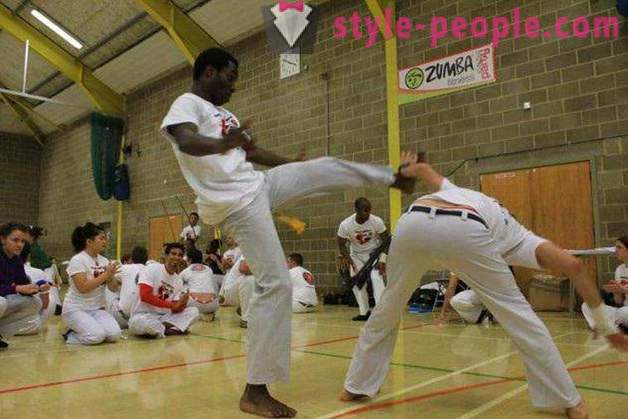
The origin of the modern variations of
Closer to the 19th century, capoeira began to be forgotten, and soon all gone underground with the other manifestations of African culture, illicit power. People who practice this form of martial arts, risked jail for a period of 2 to 6 months, and for teachers of capoeira, this period is doubled.
Many historians say that just at that time a kind of martial art, through which slaves fought the colonists turned to dance. That is, when approaching police officers, soldiers instantly changed the rhythm and the match immediately turned into a dance.
School of Capoeira for Beginners available at the time of occurrence of this sport. But anyone could easily visit the places where trained both beginners and professionals.
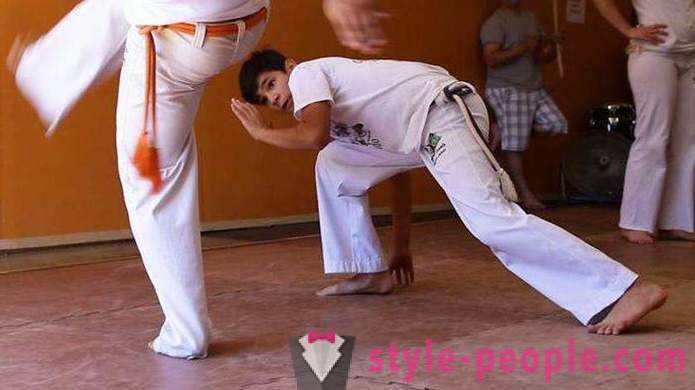
to
Directions and styles
In each region, a kind of martial arts has evolved in different ways, so at the moment there is a huge variety of styles. The most striking example is the capoeira in Rio de Janeiro. There is only formed as a martial art, and its mandatory attributes have been and are still knives, sticks and blades. No less interesting option, which was formed in the state of Bahia. Here capoeira became a ritual, accompanied by the beginning of the music, and no match could not pass without the sound of the berimbau (national musical instrument with one string).
As of today, we must distinguish between the following types of capoeira:
- Angola. It is considered a game exclusively planners and schemers. This option is very similar to a normal game game of chess, in which one of the partners creates a certain situation, and the second - out of it and start a counterattack. This game is quite slow in rhythm, so each player has an opportunity to strike a quick and unexpected blow. The founder of this style is the master of Mestre Pastinha, to share its experience and ideology in the famous book titled "Capoeira Angola".
- Regional. This game of power and speed, developed by Mestre Bimba in the 20th century, characterized by rapid strokes, sweeps, the highest speed and throws. The creator of the direction wanted to do a martial art more effective, to his successors were able to apply the skills in battles with other arts.
- Mudzhino. Style, which is a game interaction and mobility, was designed Mestre Suassuna. This person said that the new fighters really have forgotten tradition. The founder has spent over 16 years trying to develop techniques and exercises, where it joins the technique and expression of Angola, as well as the speed and dynamics Regional. This style differs from the others in that the partners are in close proximity to each other, showing his dynamic force.
- Kontemporanya. Similar to the previous style, combining tradition Regional's, Angola, as well as elements of acrobatics. Such Capoeira for Beginners is not really suitable, since it is necessary to become familiar with other areas. Although some exercises here can be used as a workout.
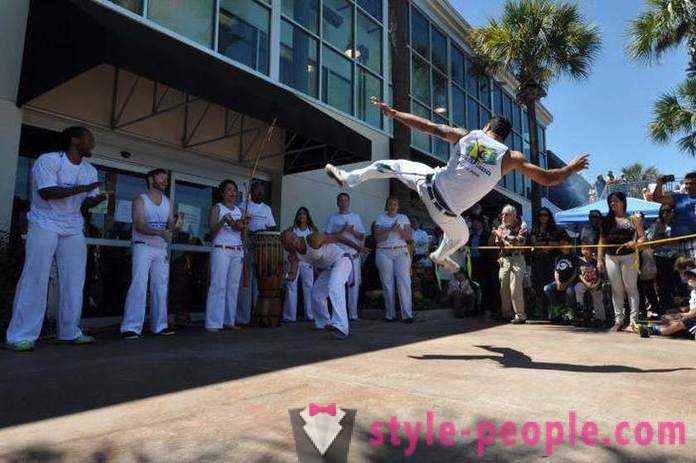
Playing in a circle
Modern capoeira study on movement drills, which are subsequently used in a way, that is, playing in a circle. The spectators form a circle at the center located a few people owning musical instruments, and then heard the sound of the berimbau, a couple of players shake hands and begin the game. After a while, there is a third player, who buys one of the partners have already played and takes his place.
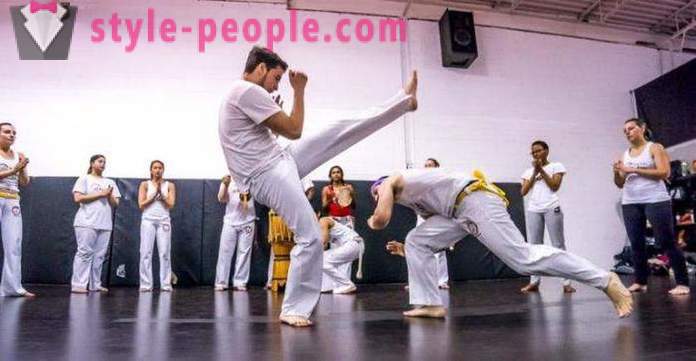
Capoeira: Music
In this martial art, combined with dance, there are a lot of features. The most interesting part of the capoeira classes - music. It sets the rhythm, making the game more meaningful. Experienced people with the help of music and songs narrate an instructive story, and celebrate the amazing game or any unusual moment in it. Therefore, in each game always present musical instruments such as:
- berimbau - odnostrunny tool that consists of a gourd, a wooden bow and metal strings;
- pandeiro - a kind of tambourine;
- atabaque - large drum;
- agogô - small bell;
- reco-reco - stick with notches, make sounds with the help of friction.
Dance
The current master special attention is paid to dance capoeira. They believe that this condition is necessary for the harmonious and rhythmic interaction partners. All movements should not be separated from each other, for which many of today's capoeiristas regularly attend additional classes forro, African, maculelê and so on.
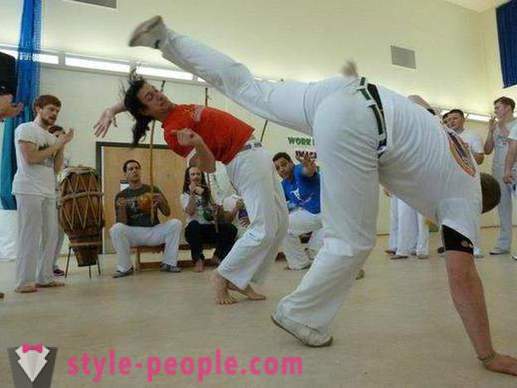
Belt
Any capoeira school for children and adults provides players with a special belt during the "baptism of fire". Each year, students are earning a new belt, studying and demonstrating the movement, as well as taking part in the seminars.












































